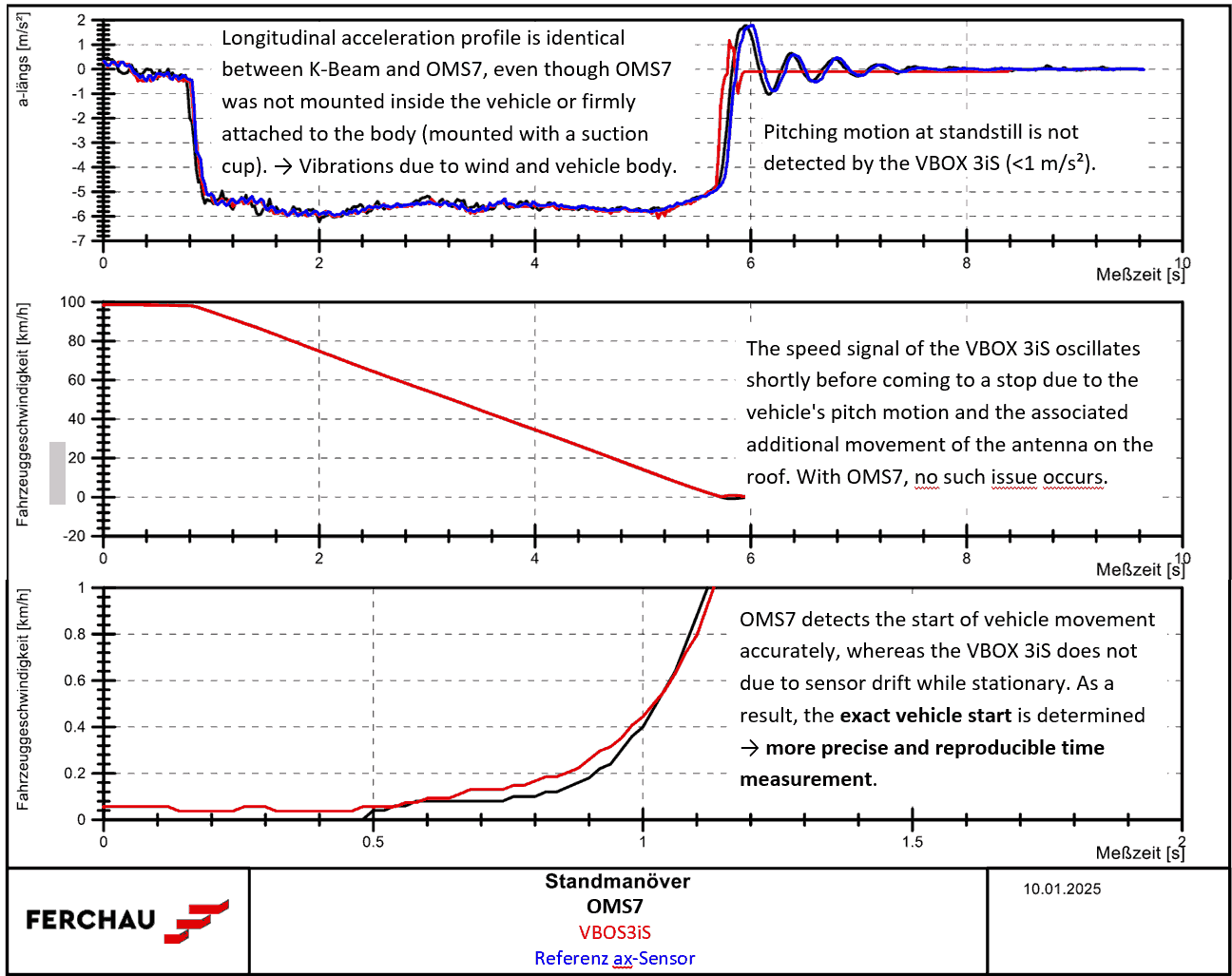1. Introduction
In today’s highly competitive automotive development landscape, objective and high-resolution measurement of vehicle dynamics is crucial for assessing performance and defining benchmark targets. FERCHAU Automotive GmbH, a leading engineering service provider in the automotive industry, supports its clients from concept development to series production, fostering innovative solutions in vehicle technology. This report presents the results of our measurement campaign using the OMS 7 sensor, which was employed to objectively capture the longitudinal dynamic behavior of our test vehicles. The report outlines the methodology, key findings, and advantages of the OMS 7 sensor compared to conventional measurement systems.
2. Application at FERCHAU Automotive GmbH
The OMS 7 sensor was utilized as a central measurement instrument in our benchmark tests. The primary objectives of these measurements were:
- Objective evaluation of longitudinal dynamic behavior:
The OMS 7 sensor enabled precise recording of acceleration and speed profiles, allowing an objective analysis of the vehicle’s longitudinal behavior. - Assessment of the current development status and target setting:
The collected data served as the basis for analyzing the current performance level and defining realistic development goals.
3. Measurement Methodology
3.1 Sensor Integration and Setup
The OMS 7 sensor was mounted at suitable locations in the vehicle to provide meaningful data within the benchmark tests. Unlike conventional GPS-based measurement systems—such as the VBOX 3iS—the OMS 7 sensor delivers reliable data even when the vehicle is stationary, as it does not require wait times to compensate for sensor drift. This allows for precise analysis even during standstill maneuvers.

Fig. 1: Installation of the Measurement Systems
3.2 Comparison with Established Measurement Systems
During the benchmark tests, the results of the OMS 7 sensor were compared with those of a proven measurement system and a capacitive K-Beam acceleration sensor (used as a reference). Initial evaluations indicate that:
- The OMS 7 sensor detects the exact start of acceleration maneuvers immediately, whereas other systems sometimes struggle due to drift effects while the vehicle is stationary.
- The recorded acceleration profiles closely match the reference data from the K-Beam sensor, indicating high reproducibility and accuracy.
- The advanced capabilities of the OMS 7 sensor open up additional application fields, such as the future analysis of lateral dynamics.
3.3 Comparison with the VBOX 3iS
A direct comparison between the OMS 7 sensor and the GPS-based VBOX 3iS system highlights several key differences, which are also illustrated in the attached graphic:
- Detection of Acceleration Start:
The OMS 7 sensor instantly recognizes the exact moment acceleration begins, whereas the VBOX 3iS experiences a slight delay due to drift while stationary. This results in more precise and reproducible time measurements for vehicle start events. - Signal Accuracy and Stability:
While the longitudinal acceleration signals from the OMS 7 sensor match the reference data, the VBOX 3iS only starts transmitting data from an acceleration threshold of 1 m/s². Additionally, speed signals from the VBOX 3iS exhibit oscillations due to vehicle pitch movements just before coming to a stop, an issue not observed with the OMS 7 sensor . - Enhanced Benchmarking Capabilities:
Thanks to its superior performance at low speeds and standstill conditions, the OMS 7 sensor provides a more reliable assessment of vehicle behavior. The ability to capture detailed dynamic behavior while stationary lays the groundwork for further analyses, particularly in the field of lateral dynamics.
Note: The attached graphic illustrates these differences and supports the presented analysis.

Fig. 2: Comparison of the Measurement Systems
4. Advantages of the OMS 7 Sensor
The conducted measurements highlight several key advantages of the OMS 7 sensor:
- No waiting time due to drift-free operation:
Unlike GPS-based systems, the OMS 7 sensor does not require waiting time for stable measurement values. As a result, data can be captured immediately from a standstill. - Higher accuracy in standstill maneuvers:
The optical-inertial measurement technology ensures precise data even at low speeds and in static driving situations, which is particularly beneficial for benchmarking analyses. - Expansion of application areas:
In addition to evaluating longitudinal dynamics, the OMS 7 sensor also offers the possibility of detailed lateral dynamics analysis in the future — a field that could not be effectively covered by previous measurement systems.
5. Benchmarking and Target Setting
The collected data was used to objectively assess the current state of vehicle dynamics. By precisely capturing vehicle behavior, realistic target values could be defined, serving as a foundation for further optimizations. The key benefits include:
- Faster data acquisition:
The immediate readiness of the OMS 7 sensor significantly shortens test cycles. - Improved reproducibility:
High measurement accuracy and the elimination of drift effects enable consistent and reliable evaluation of driving scenarios. - Expanded analysis capabilities:
The detailed datasets provide a solid foundation for comprehensive analyses of both longitudinal and, in the future, lateral dynamics.
6. Conclusion
The integration of the OMS 7 sensor into our measurement campaigns at FERCHAU Automotive GmbH clearly demonstrates that state-of-the-art optical-inertial measurement technology represents a quantum leap in vehicle dynamics analysis. The OMS 7 sensor is not only drift-free and extremely precise — especially in static driving situations — but also opens up entirely new possibilities in data acquisition. Its ability to detect even the finest dynamic changes immediately and reliably makes it an industry benchmark.
With the OMS 7, we are setting an innovative standard that outperforms conventional GPS-based systems and paves the way for future developments in vehicle technology.
This groundbreaking technology allows us to conduct objective evaluations of the current development status at a new level while simultaneously setting realistic and ambitious target values for further advancements.
“The OMS 7 sensor is undoubtedly the most advanced optical measurement system currently available – a true game-changer. A big thank you also goes to the team behind the product for the very pleasant and highly professional collaboration.”
– Dominic-Marcel Elsner, FERCHAU Automotive GmbH
